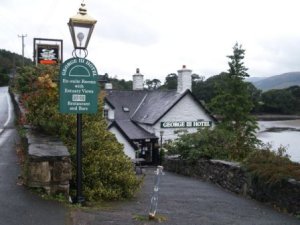The small bus reeked of hot brakes – all the fault of our tour guide: R. S. Thomas.
Ten of us hired a driver and a small bus for touring England and Wales. Thomas joined us when we arrived in Wales, and sat by the driver to give him directions.
Unclouded sunshine brought out the natural beauty of Wales, as R. S. led us along Tal-y-llyn, a lake from whose shore we had a clear view of Cader Idris, which means “chair of Idris,” a giant variously celebrated by the Welsh bards as warrior, poet, and astronomer. According to tradition, anyone sleeping for a night in the chair of Idris wakes up as a poet or a madman. But no one knows the precise throne-like stone that is Idris’s chair.
We drove on to Dolgellau, where Thomas told the driver to turn onto a one-track road. Before long, he realized that he’d picked the wrong turning. So back to Dolgellau, where he asked for directions, which took us to another single-track road that was blocked again and again by gates to keep sheep from straying.
Soon the road plunged downward, and we began to smell overheating brakes. The road flattened just before we reached Penmaenpool on the river Mawddach, where Thomas announced we’d eat lunch at the George III Hotel.
Surely, R.S. grinned inwardly: A Welshman taking ten Americans to an inn named for the English king that Americans love to hate. And the Welsh, too, are not overly fond of English monarchs. Yet Thomas, self-crowned arbiter of pure Welshness, received the English Queen’s Gold Medal for Poetry.
R.S. treated me to a pint of bitter in the pub; then each of us had steak and kidney pie with chips and peas, which is quintessential English pub fare.
No one knows precisely where R. S. Thomas lives in the borders between Welshness and Englishness.



I’m willing to take the chance on Cader Idris as all poets are slightly mad anyway… Good to see photos of some of the places I’m reading about in the book.
My son found the picture of Cader Idris. When I look at it, what I see is Idris’s sitz bath.
No doubt, it’s the hint of madness that attracts me to poets.
The journey was described with a relish – I could smell the brakes. Loved the mysterious punchline.
I can still smell the brakes, but the aroma of the steak and kidney pie overcame it.
Ah, the punchline. Stay tuned. One clue: the area between England and Wales is called The Borders. There’s a clear boundary line on maps, but on the ground it’s rather nebulous. It’s also called The Marches, because English and Welsh fighting men marched back and forth through the area for centuries. English nobles who built castles in the region were the Marcher Lords, or Lords of The Marches.
Many thanks to you, sir!